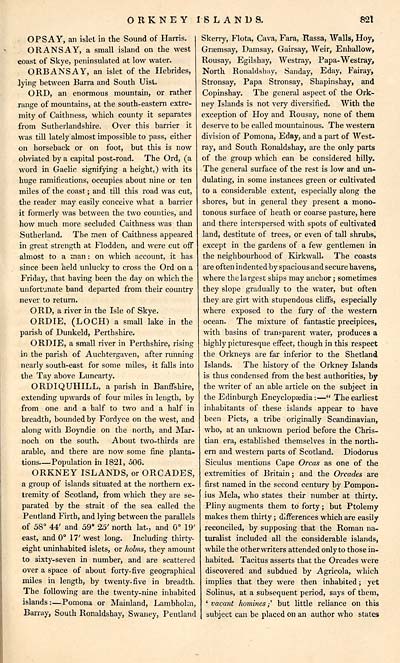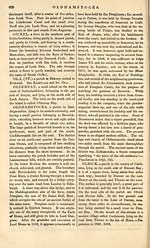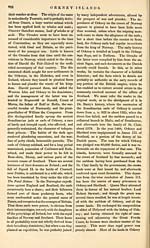Gazetteer of Scotland > Volume 2
(337) Page 821
Download files
Complete book:
Individual page:
Thumbnail gallery: Grid view | List view

ORKNEY ISLANDS.
821
OP SAY, an islet in the Sound of Harris.
ORANSAY, a small island on the west
coast of Skye, peninsulated at low water.
ORBANSAY, an islet of the Hebrides,
lying between Barra and South Uist.
ORD, an enormous mountain, or rather
range of mountains, at the south-eastern extre-
mity of Caithness, which county it separates
from Sutherlandshire. Over this barrier it
was till lately' almost impossible to pass, either
on horseback or on foot, but this is now
obviated by a capital post-road. The Ord, (a
word in Gaelic signifying a height,) with its
huge ramifications, occupies about nine or ten
miles of the coast ; and till this road was cut,
the reader may easily conceive what a barrier
it formerly was between the two counties, and
how much more secluded Caithness was than
Sutherland. The men of Caithness appeared
in great strength at Flodden, and were cut off
almost to a man : on which account, it has
since been held unlucky to cross the Ord on a
Friday, that having been the day on which the
unfortunate band departed from their country
never to return.
ORD, a river in the Isle of Skye.
ORD IE, (LOCH) a small lake in the
parish of Dunkeld, Perthshire.
ORDIE, a small river in Perthshire, rising
in the parish of Auchtergaven, after running
nearly south-east for some miles, it falls into
the Tay above Luncarty.
ORDIQUHILL, a parish in Banffshire,
extending upwards of four miles in length, by
from one and a half to two and a half in
breadth, bounded by Fordyce on the west, and
along with Boyndie on the north, and Mar-
noch on the south. About two-thirds are
arable, and there are now some fine planta-
tions. — Population in 1821, 506.
ORKNEY ISLANDS, or ORCADES,
a group of islands situated at the northern ex-
tremity of Scotland, from which they are se-
parated by the strait of the sea called the
Pentland Firth, and lying between the parallels
of 58° 44' and 59" 25' north lat., and 0° 19'
east, and 0° 17' west long. Including thirty-
eight uninhabited islets, or holms, they amount
to sixty-seven in number, and are scattered
over a space of about forty-five geographical
miles in length, by twenty-five in breadth.
The following are the twenty-nine inhabited
islands: — Pomona or Mainland, Lambholm,
Barray, South Ronaldshay, Swaney, Pentland
Skerry, Flota, Cava, Fara, Rassa, "Walls, Hoy,
Graemsay, Damsay, Gairsay, Weir, Enhallow,
Rousay, Egilshay, Westray, Papa-Westray,
North Ronaldshay, Sanday, Eday, Fairay,
Stronsay, Papa Stronsay, Shapinshay, and
Copinshay. The general aspect of the Ork-
ney Islands is not very diversified. With the
exception of Hoy and Rousay, none of them
deserve to be called mountainous. The western
division of Pomona, Eday, and a part of West-
ray, and South Ronaldshay, are the only parts
of the group which can be considered hilly.
The general surface of the rest is low and un-
dulating, in some instances green or cultivated
to a considerable extent, especially along the
shores, but in general they present a mono-
tonous surface of heath or coarse pasture, here
and there interspersed with spots of cultivated
land, destitute of trees, or even of tall shrubs,
except in the gardens of a few gentlemen in
the neighbourhood of Kirkwall. The coasts
are often indented by spacious and secure havens,
where the largest ships may anchor ; sometimes
they slope gradually to the water, but often
they are girt with stupendous cliffs, especially
where exposed to the fury of the western
ocean. The mixture of fantastic precipices,
with basins of transparent water, produces a
highly picturesque effect, though in this respect
the Orkneys are far inferior to the Shetland
Islands. The histoiy of the Orkney Islands
is thus condensed from the best authorities, by
the writer of an able article on the subject in
the Edinburgh Encyclopaedia : — " The earliest
inhabitants of these islands appear to have
been Picts, a tribe originally Scandinavian,
who, at an unknown period before the Chris-
tian era, established themselves in the north-
ern and western parts of Scotland. Diodorus
Siculus mentions Cape Orcas as one of the
extremities of Britain ; and the Orcades are
first named in the second century by Pompon-
ius Mela, who states their number at thirty.
Pliny augments them to forty ; but Ptolemy
makes them thirty; differences which are easily
reconciled, by supposing that the Roman na-
turalist included all the considerable islands,
while the other writers attended only to those in-
habited. Tacitus asserts that the Orcades were
discovered and subdued by Agricola, which
implies that they were then inhabited; yet
Solinus, at a subsequent period, says of them,
' vacant homines;' but little reliance on this
subject can be placed on an author who states
821
OP SAY, an islet in the Sound of Harris.
ORANSAY, a small island on the west
coast of Skye, peninsulated at low water.
ORBANSAY, an islet of the Hebrides,
lying between Barra and South Uist.
ORD, an enormous mountain, or rather
range of mountains, at the south-eastern extre-
mity of Caithness, which county it separates
from Sutherlandshire. Over this barrier it
was till lately' almost impossible to pass, either
on horseback or on foot, but this is now
obviated by a capital post-road. The Ord, (a
word in Gaelic signifying a height,) with its
huge ramifications, occupies about nine or ten
miles of the coast ; and till this road was cut,
the reader may easily conceive what a barrier
it formerly was between the two counties, and
how much more secluded Caithness was than
Sutherland. The men of Caithness appeared
in great strength at Flodden, and were cut off
almost to a man : on which account, it has
since been held unlucky to cross the Ord on a
Friday, that having been the day on which the
unfortunate band departed from their country
never to return.
ORD, a river in the Isle of Skye.
ORD IE, (LOCH) a small lake in the
parish of Dunkeld, Perthshire.
ORDIE, a small river in Perthshire, rising
in the parish of Auchtergaven, after running
nearly south-east for some miles, it falls into
the Tay above Luncarty.
ORDIQUHILL, a parish in Banffshire,
extending upwards of four miles in length, by
from one and a half to two and a half in
breadth, bounded by Fordyce on the west, and
along with Boyndie on the north, and Mar-
noch on the south. About two-thirds are
arable, and there are now some fine planta-
tions. — Population in 1821, 506.
ORKNEY ISLANDS, or ORCADES,
a group of islands situated at the northern ex-
tremity of Scotland, from which they are se-
parated by the strait of the sea called the
Pentland Firth, and lying between the parallels
of 58° 44' and 59" 25' north lat., and 0° 19'
east, and 0° 17' west long. Including thirty-
eight uninhabited islets, or holms, they amount
to sixty-seven in number, and are scattered
over a space of about forty-five geographical
miles in length, by twenty-five in breadth.
The following are the twenty-nine inhabited
islands: — Pomona or Mainland, Lambholm,
Barray, South Ronaldshay, Swaney, Pentland
Skerry, Flota, Cava, Fara, Rassa, "Walls, Hoy,
Graemsay, Damsay, Gairsay, Weir, Enhallow,
Rousay, Egilshay, Westray, Papa-Westray,
North Ronaldshay, Sanday, Eday, Fairay,
Stronsay, Papa Stronsay, Shapinshay, and
Copinshay. The general aspect of the Ork-
ney Islands is not very diversified. With the
exception of Hoy and Rousay, none of them
deserve to be called mountainous. The western
division of Pomona, Eday, and a part of West-
ray, and South Ronaldshay, are the only parts
of the group which can be considered hilly.
The general surface of the rest is low and un-
dulating, in some instances green or cultivated
to a considerable extent, especially along the
shores, but in general they present a mono-
tonous surface of heath or coarse pasture, here
and there interspersed with spots of cultivated
land, destitute of trees, or even of tall shrubs,
except in the gardens of a few gentlemen in
the neighbourhood of Kirkwall. The coasts
are often indented by spacious and secure havens,
where the largest ships may anchor ; sometimes
they slope gradually to the water, but often
they are girt with stupendous cliffs, especially
where exposed to the fury of the western
ocean. The mixture of fantastic precipices,
with basins of transparent water, produces a
highly picturesque effect, though in this respect
the Orkneys are far inferior to the Shetland
Islands. The histoiy of the Orkney Islands
is thus condensed from the best authorities, by
the writer of an able article on the subject in
the Edinburgh Encyclopaedia : — " The earliest
inhabitants of these islands appear to have
been Picts, a tribe originally Scandinavian,
who, at an unknown period before the Chris-
tian era, established themselves in the north-
ern and western parts of Scotland. Diodorus
Siculus mentions Cape Orcas as one of the
extremities of Britain ; and the Orcades are
first named in the second century by Pompon-
ius Mela, who states their number at thirty.
Pliny augments them to forty ; but Ptolemy
makes them thirty; differences which are easily
reconciled, by supposing that the Roman na-
turalist included all the considerable islands,
while the other writers attended only to those in-
habited. Tacitus asserts that the Orcades were
discovered and subdued by Agricola, which
implies that they were then inhabited; yet
Solinus, at a subsequent period, says of them,
' vacant homines;' but little reliance on this
subject can be placed on an author who states
Set display mode to: Large image | Transcription
Images and transcriptions on this page, including medium image downloads, may be used under the Creative Commons Attribution 4.0 International Licence unless otherwise stated. ![]()
| Gazetteers of Scotland, 1803-1901 > Gazetteer of Scotland > Volume 2 > (337) Page 821 |
|---|
| Permanent URL | https://digital.nls.uk/97434866 |
|---|
| Description | Volume II: Glenbanchor to Zetland. |
|---|---|
| Attribution and copyright: |
|
| Description | By Robert Chambers and William Chambers. Glasgow: Blackie & Son, 1838. 2 volumes. |
|---|---|
| Shelfmark | NF.1461.g.7 |
| Additional NLS resources: | |

